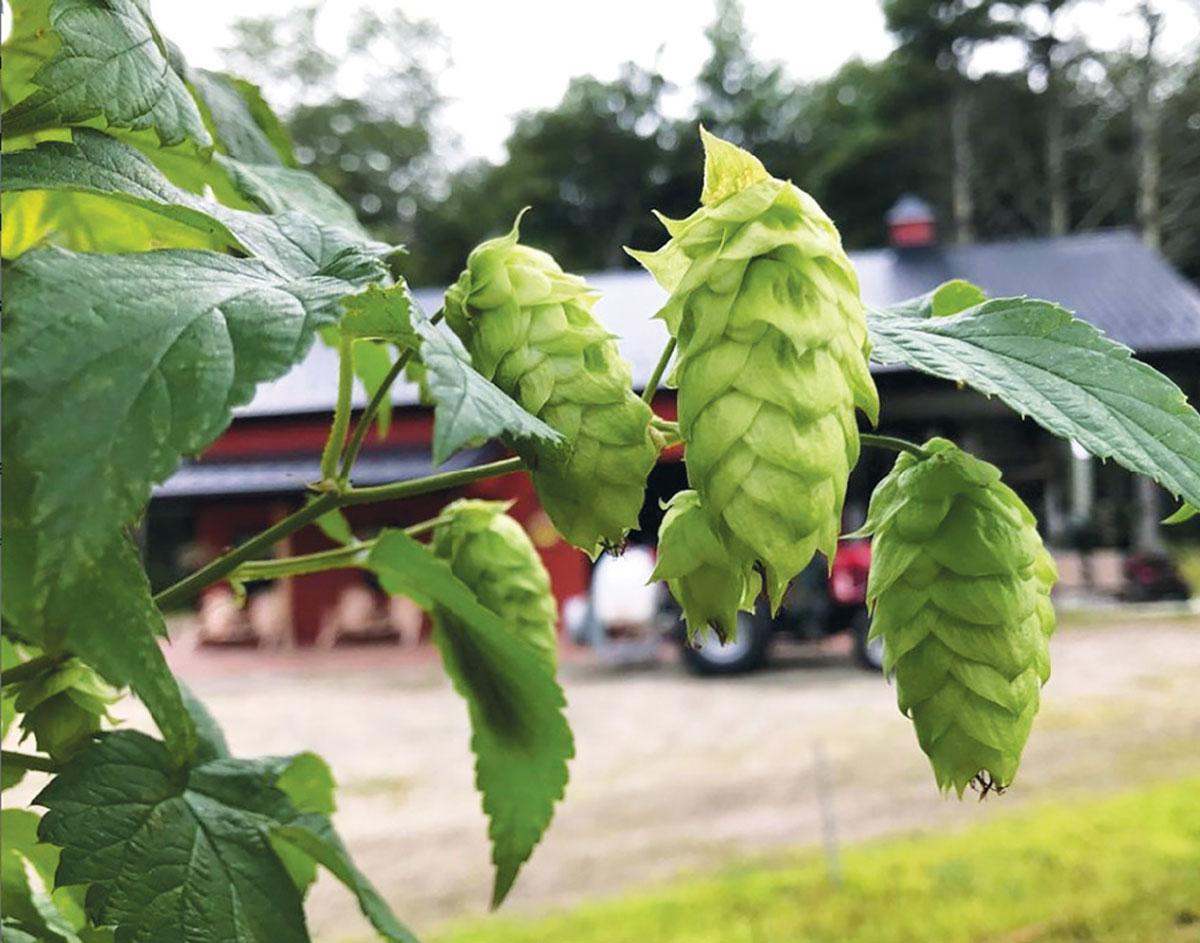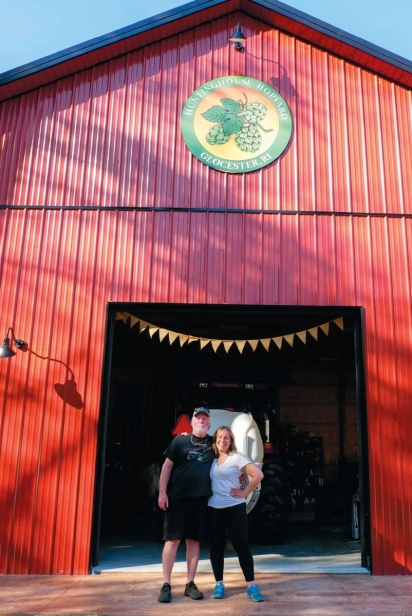Huntinghouse Hopyard
Rhody-Grown Hops for Rhody-Made Beer
Have you ever been sitting around a table, maybe drinking beer, and someone says that they are about to do some really big thing? It happens often enough, and you dismiss it as just talk, because in that kind of setting people often say things they don’t really mean. Only in this case, the setting was Long Live Beerworks in Providence, and the talkers were Bob and Lynn Butler, enthusiastic disciples in the local beer scene for years. On that fateful night, they announced that they were going to start a hop farm—and they really meant it!
Starting a hop farm is no small endeavor. The amount of preparation, infrastructure and investment required before anything even gets planted is enough to scare away even the most quixotic dreamers. The Butlers, who live in Glocester, understood most of this going in, but they were excited about the idea and wanted to move forward. (Bob, now full time at the farm, worked in carpentry, auto mechanics and was a full-time dad. When not on the farm, Lynn still works “every other spare minute” at the ultrasound business she owns.) “Our neighbors were selling the land next to us; we didn’t want houses to go in there, so we made the decision to buy the land,” says Bob. The idea of being further integrated into the world of brewing was also appealing. Compared to what followed, that was the easiest part.
“We cleared four acres so that we would have enough space to plant two acres of hops,” says Bob. There were rocks and stumps, high and low points, and the whole area needed to be tilled. “Our initial plan consisted of building a trellis and getting plants,” says Lynn. The couple went to conferences and did a whole lot of research. They amended the acidic soil with 30 tons of lime and added fertilizer.
They hired a surveyor to measure out evenly placed stakes where the posts would go. One hundred seventy poles, each 22 feet in length, were fashioned from locally grown cedar trees. “We rented an auger to make holes for the posts and found lots of underground rocks,” Bob says with a laugh. It took the entire summer just to set the posts—each buried four feet into the ground. The following fall and winter were devoted to positioning and anchoring the cables. They finally sunk the first few plants in the spring of 2019.
Back in 2018, the Butlers were able to acquire a Wolf Hop Harvester shipped here from Poland. It is a very large, highly specialized piece of equipment that saves so much labor at harvest time that it can be considered indispensable. Buying a harvester a full year before setting plants that take three years to produce a crop is emblematic of the level of dedication at Huntinghouse Farm.
Now, five years later, the hop farm has found its seasonal stride. Winters are devoted to equipment maintenance, planning and general upgrades. April through June, Bob and Lynn set coconut fiber strings—2,600 of them, to be exact. It is an arduous task, so they work together setting two rows a day, tying the tops and anchoring the bottoms in preparation for the climbing hop vines.
During the summer growing season, they scout for issues such as loose cables, mold and insects. Irrigation is constant and fertilizer is often added. Then comes the real work.
Harvest time is when things really matter. Lynn and Bob have been partners since high school. They raised three children and know how to work together. That’s good, because everything comes due almost all at once. Teamwork is crucial during the harvest. “We’ve developed a good crew of volunteers who know what to do and come to help each year,” says Bob. Cutting the strings, removing the vines and feeding them into the harvester makes for some long days and hard work. Thankfully, different varieties have different harvest times, so the crew can get a short break.
“Just because the hop cones are harvested doesn’t mean that we can relax,” says Lynn. The shelf life of a freshly harvested hop cone can be measured in days. They must be dried and pelletized if they are not going to be used immediately. “We hope to do more wet hopping in coming years,” says Bob. Wet hopping is when brewers use the hop cones immediately after harvest. It requires close coordination with local brewers, and timing is critical. Hops spoil quickly after harvest and fresh hops are known for their flavor and quality. Therein lies the central principle for the whole operation. Local breweries seek to produce the finest beers that they can make so the addition of locally grown fresh hops is a natural choice.
“Their Cascade hops are the best that I’ve ever used,” says Justin Tisdale, head brewer at Rejects Brewing Co. in Newport. “They are more expensive, and worth every penny,” he adds. “We look forward to brewing beer in conjunction with the harvest schedule this fall.”
At Bravo Brewing Co. in Pascoag, co-owners Brianna Hughes and Chris Mishoe love using hops that are grown just eight miles away. “Hops grown by the large-scale producers in the Pacific Northwest are cheaper, but these are way better,” says Mishoe.
As the local brewing scene continues to grow and enjoy the full embrace of the beer-drinking public, there is abundant space for locally grown hops. Perhaps one day, the entire Huntinghouse crop will be harvested, distributed and used by local breweries within days of harvest. That is the goal.
William Tuthill is a writer who attended Cornell University’s College of Agriculture and Life Sciences in Ithaca, NY. He lives with his family in Jamestown.
For more information, visit HuntinghouseHopyard.com or follow them on social @huntinghousehopyard.






